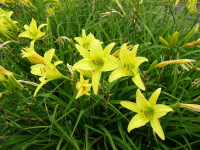Description
Midsummer, fragrant lemon yellow trumpets
Midsummer, fragrant lemon yellow trumpets
Midsummer, fragrant lemon yellow trumpets
SHRUB Boxwood
Size: 24” x 30”
Care: Light to Part shade in well drained, alkaline soil. Do not crowd with other plants, roots prefer no competition. Fertilize regularly for dramatic growth. Prune in early spring. Unlike English boxwood this can be pruned back hard. One of a few shade tolerant evergreens and deer resistant too. Also the most hardy Boxwood.
Introduced from Asia to American and European gardens around 1900 by Ernest Henry “Chinese” Wilson (1876-1930) who scoured Asia for plants.
OUT OF STOCK
All summer long, droves of lavender blossoms above a mini pillow of spoon-shaped, glossy foliage.
Size: 6-8” x 6-8”
Care: sun in well-drained soil
Native: southeast France on limestone seacliffs
Wildlife Value: deer resistant, salt tolerant
Described by Linnaeus, 1753. The name Limoniuim comes from the Greek word for meadow.
OUT OF STOCK
Lavender-Pink outside and white inside funnels in June
Size: 20” x 12-24”
Care: sun in well-drained soil
Native: northeast North America
Wildlife Value: attracts Baltimore butterfly and feeds the Rusty patched Bumble Bee
Penstemon is named for its five stamens, penta meaning “five” and stemon meaning “stamen” in Greek. Penstemons are “handsome and deserving,” Bailey. P. hirsutus sent from America to England in 1758.
OUT OF STOCK
Green flowers in summer then, “conspicuous in winter when covered with its grayish white fruits which stay on the branches until spring.” Bailey “The leaves turn a fine brown-purple in the fall, but the berries are the thing – pewter in color, with a texture like those Fourth of July sparklers of childhood memory, they have a delicious fragrance.” Allen Lacy.
Size: 9’ x 10’
Care: sun in any soil
Native: Canada to Southeastern U.S. No pruning needed but can be pruned at any time of year, if desired.
Wildlife Value: Berries relished by chickadees, red-bellied woodpeckers, swallows, Titmouse, catbirds, bluebirds, Northern flicker & yellow-rumped warblers. Bayberry thickets also provide nesting sites for songbirds, offering excellent protection from predators.
Probably 1st collected for gardens by John Bartram (1699-1776). Offered for sale in Bartram Garden’s 1783 Broadside, America’s 1st plant catalog. In 1800’s considered “very ornamental in the shrubbery.” Fragrant leaves used for potpourri, abundant berries used to make candles. Good road-side plant, salt tolerant. Berries used to make candles. Boil berries (drupes) to melt wax coating. Collect wax from surface of water. In American Medicinal Plants Charles F. Millspaugh noted that “Candles made from this wax, though quite brittle, are less greasy in warm weather, of fine appearance, slightly aromatic, and smokeless after snuffing, rendering them much more pleasant to use than those made of either wax (paraffin) or tallow (animal fat).” 1892.

